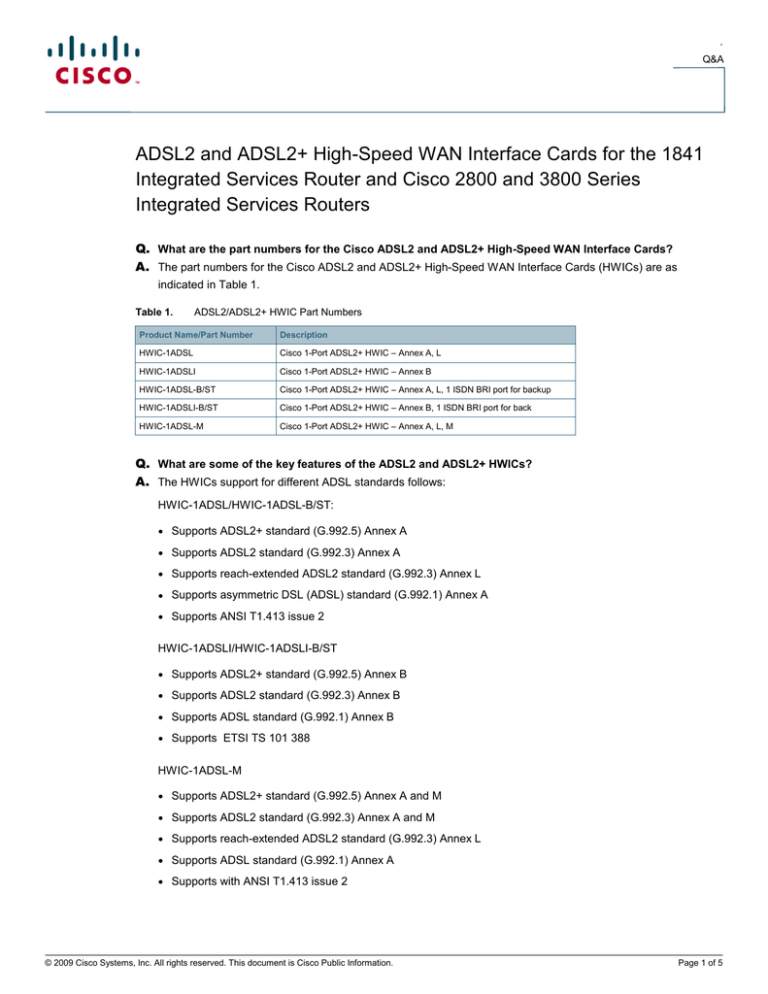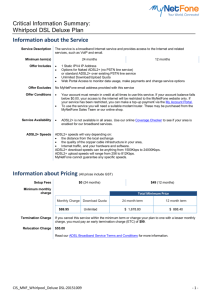
.
Q&A
ADSL2 and ADSL2+ High-Speed WAN Interface Cards for the 1841
Integrated Services Router and Cisco 2800 and 3800 Series
Integrated Services Routers
Q. What are the part numbers for the Cisco ADSL2 and ADSL2+ High-Speed WAN Interface Cards?
A. The part numbers for the Cisco ADSL2 and ADSL2+ High-Speed WAN Interface Cards (HWICs) are as
indicated in Table 1.
Table 1.
ADSL2/ADSL2+ HWIC Part Numbers
Product Name/Part Number
Description
HWIC-1ADSL
Cisco 1-Port ADSL2+ HWIC – Annex A, L
HWIC-1ADSLI
Cisco 1-Port ADSL2+ HWIC – Annex B
HWIC-1ADSL-B/ST
Cisco 1-Port ADSL2+ HWIC – Annex A, L, 1 ISDN BRI port for backup
HWIC-1ADSLI-B/ST
Cisco 1-Port ADSL2+ HWIC – Annex B, 1 ISDN BRI port for back
HWIC-1ADSL-M
Cisco 1-Port ADSL2+ HWIC – Annex A, L, M
Q. What are some of the key features of the ADSL2 and ADSL2+ HWICs?
A. The HWICs support for different ADSL standards follows:
HWIC-1ADSL/HWIC-1ADSL-B/ST:
●
Supports ADSL2+ standard (G.992.5) Annex A
●
Supports ADSL2 standard (G.992.3) Annex A
●
Supports reach-extended ADSL2 standard (G.992.3) Annex L
●
Supports asymmetric DSL (ADSL) standard (G.992.1) Annex A
●
Supports ANSI T1.413 issue 2
HWIC-1ADSLI/HWIC-1ADSLI-B/ST
●
Supports ADSL2+ standard (G.992.5) Annex B
●
Supports ADSL2 standard (G.992.3) Annex B
●
Supports ADSL standard (G.992.1) Annex B
●
Supports ETSI TS 101 388
HWIC-1ADSL-M
●
Supports ADSL2+ standard (G.992.5) Annex A and M
●
Supports ADSL2 standard (G.992.3) Annex A and M
●
Supports reach-extended ADSL2 standard (G.992.3) Annex L
●
Supports ADSL standard (G.992.1) Annex A
●
Supports with ANSI T1.413 issue 2
© 2009 Cisco Systems, Inc. All rights reserved. This document is Cisco Public Information.
Page 1 of 5
Q&A
In addition, the following features are common to all the ADSL, ADSL2, and ADSL2+ HWICs:
●
Supports ATM Adaptation Layer 5 (AAL5) services
●
Supports ATM class-of-service (CoS) features constant bit rate (CBR), non-real-time variable bit rate (VBRnrt), real-time variable bit rate (VBR-rt), and unspecified bit rate (UBR)
●
Supports up to 23 virtual circuits per HWIC
●
Supports IP quality of service (QoS)
●
Supports Dying Gasp function
Q. Which platforms support the HWICs?
A. Cisco 1841, 2801, 2811, 2821, 2851, 3825, and 3845 Integrated Services Routers support the HWICs. The
Cisco 1700 and 3700 Series Modular Access Routers and Cisco 2600 and 3600 Series Multiservice Platforms
do not support the HWICs. Table 2 gives the number of ADSL HWICs supported on each platform. The ADSL
HWICs function in built-in HWIC slots of the integrated services routers only.
Table 2.
Number of ADSL HWICs Supported by Cisco Integrated Services Routers
Platform
Maximum ADSL HWICs per Platform
Cisco 1841 and 2801
2
Cisco 2811 through Cisco 2851, and Cisco 3825 through Cisco 3845
4
Q. Which Cisco IOS® Software release and firmware are required?
A. Cisco IOS Software Release-to-ADSL Firmware Mapping for ADSL2 and ADSL2+ HWICs at first customer
shipment (FCS) and later is shown Table 3.
Table 3.
Cisco IOS Software Release and Firmware Mapping
HWIC-1ADSL/HWIC-1ADSL-B/ST
HWIC-1ADSLI/HWIC-1ADSLI-B/ST
HWIC-1ADSL-M
Default Firmware
Version
Cisco IOS Software
Releases Supported
Default Firmware
Version
Cisco IOS Software
Releases Supported
Default Firmware
Version
Cisco IOS Software
Releases Supported
2.5.27
12.4(4)T
2.5.27
12.4(4)T
2.5.42
12.4(6)T
2.5.42
12.4(6)T
2.5.42
12.4(9)T
2.5.42
12.4(9)T
3.0.14
12.4(11)XJ, 12.4(15)T
3.0.14
12.4(11)XJ, 12.4(15)T
3.0.14
12.4(11)XJ, 12.4(15)T
The firmware version is subject to change. For more detail and future updates on Cisco IOS Software release-toDSL firmware version mapping, please go to:
http://www.cisco.com/en/US/partner/prod/collateral/routers/ps221/prod_bulletin0900aecd801d5c4c.html
Q. Is it possible to configure the HWIC in the WIC mode?
A. No, it is not possible to configure the HWIC in WIC mode. The HWICs are compatible with the HWIC slots only
on the Cisco 1841, 2800, and 3800 Integrated Services Routers.
Q. Why is the DSL access multiplexer (DSLAM) firmware version listed in the Interoperability table in the
data sheet?
A. The DSLAM firmware version is listed in the data sheet because it is the firmware against which Layer one
interoperability testing has been performed within Cisco. DSLAM vendors sometimes release new firmware
versions for existing DSLAM line cards to add support for new software and hardware features. When the
firmware upgrade is done only on the DSLAM side, it can result in interoperability problems between customer
premises equipment (CPE) and the DSLAM.
© 2009 Cisco Systems, Inc. All rights reserved. This document is Cisco Public Information.
Page 2 of 4
Q&A
Q. What are the differences in data rates for the ADSL, ADSL2, and ADSL2+ standards?
A. ADSL, the G.992.1 standard, enables communications of up to 0.8 Mbps upstream and up to 8 Mbps
downstream.
ADSL2, the G.992.3 standard, increases downstream data rates of up to 12 Mbps, and upstream data rates of
up to 1 Mbps.
ADSL2+, the G.992.5 standard, doubles the maximum frequency used for downstream data transmission from
1.1 to 2.2 MHz, effectively providing downstream data rates of up to 24 Mbps at a distance of up to 5000 feet
from the central office, and upstream data rates of up to 1.5 Mbps.
The exact data rates vary, depending on the distance from the DSLAM, DSLAM type, line card and chipset, and
firmware, noise profile, quality of copper, etc.
A plot of downstream data for the different ADSL standards shows approximate reaches in Figure 1.
Figure 1.
Approximate Reaches Achieved for Different ADSL Standards
Q. What do the different annexes specify?
A. The scope of the different annexes in G.992.5 is defined as follows:
●
Annex-A: This annex defines those parameters of the ADSL system that are unique to an ADSL service that
is frequency division multiplexed with basic telephone service.
●
Annex-B: This annex defines those parameters of the ADSL system that are unique to an ADSL service that
is frequency division multiplexed with ISDN BA on the same digital subscriber line.
●
Annex-M: This annex defines those parameters of the ADSL with an extended upstream bandwidth system
that are unique to an ADSL service that is frequency division multiplexed with basic telephone service.
●
Annex-L: This annex defines those parameters of the ADSL system that are unique to a reach-extended
ADSL2 service that is frequency division multiplexed with basic telephone service.
Q. What is Annex-M?
A. This annex-M is an annex of the G.992.3 standard that extends the upstream bandwidth. This extension is
achieved by doubling the upstream frequency range. With this feature, service providers can provision
symmetric data rates for ADSL2 and ADSL2+ services with data rates up to 2 Mbps.
© 2009 Cisco Systems, Inc. All rights reserved. This document is Cisco Public Information.
Page 3 of 4
Q&A
Q. The exact data rates vary, depending on the distance from the DSLAM, DSLAM type, line card and
chipset, and firmware, noise profile, quality of copper, etc.What does the term “mask” imply in AnnexM?
A. The mask refers to the submode power spectral density (PSD) mask applicable for Annex-M. Service providers
use the mask to minimize the cross-talk between adjacent pairs to an acceptable level. G.992.3 specifies the
masks, as shown in Table 4.
Table 4.
Annex-M Masks
Upstream Mask Number
Designator
Cutoff Frequency f1 (kHz)
Upstream Tones
Downstream Tones
1
EU-32
138.00
6–32
58–255
2
EU-36
155.25
6–36
58–255
3
EU-40
172.50
6–40
58–255
4
EU-44
189.75
6–44
58–255
5
EU-48
207.00
6–48
58–255
6
EU-52
224.25
6–52
58–255
7
EU-56
241.50
6–56
58–255
8
EU-60
258.75
6–60
61–255
9
EU-64
276.00
6–64
65–255
Q. Do the Fixed Annex M in HWIC-1ADSL-M products support the power spectral density (PSD ) Mask
required to comply with the Annex M standards in the United Kingdom?
A. No. Currently, there are no plans to support this standard.
Q. What mask does the HWIC-1ADSL-M support?
A. HWIC-1ADSL-M hardware is optimized for Mask M-9. HWIC-1ADSL-M can operate in other masks, but the
performance may be lower than a CPE that is optimized for that mask.
Q. What is INP?
A. INP stands for Impulse Noise Protection. Support for INP allows the CPE to provide error-correction capability
for impulse noise. The unit for this parameter is in number of symbols. Support for up to 16 symbols is provided
by an amendment to the original G.992.5 standard and is referred to as extended INP function (G992.5addemdum II edited on May 2005). Support for optional INP capability of at least 16 DMT symbols (INP = 16)
protects against impulse noise of up to 4 milliseconds. Increasing the INP also increases the latency.
Q. Do the ADSL, ADSL2, and ADSL2+ HWICs support extended INP functions?
A. Only the HWIC-1ADSL-M supports the extended INP functions.
Q. What ADSL chipset is used in the HWICs?
A. The HWICs use the STMicroelectronics ST20190 chipset.
© 2009 Cisco Systems, Inc. All rights reserved. This document is Cisco Public Information.
Page 4 of 4
Q&A
Printed in USA
© 2009 Cisco Systems, Inc. All rights reserved. This document is Cisco Public Information.
C67-531131-00
04/09
Page 5 of 4



